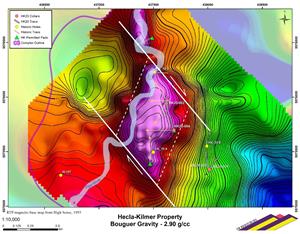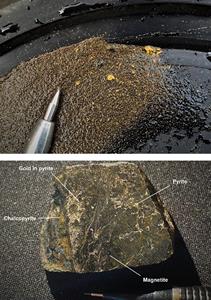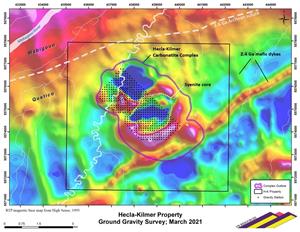VR identifies 3.5 mGal gravity anomaly at its Hecla-Kilmer property in Northern Ontario, and planning is now underway for Phase II follow-up drilling in September
VANCOUVER, British Columbia, May 05, 2021 (GLOBE NEWSWIRE) -- VR Resources Ltd. (TSX.V: VRR, FSE: 5VR; OTCBB: VRRCF), the "Company", or “VR”, is pleased to announce that it has received the final data for the detailed, ground-based gravity survey carried out in March over the multi-phase carbonatite complex on its Hecla-Kilmer property (“H-K”) located in Northern Ontario.
The result is obvious; the intervals of copper, gold and critical metal mineralization intersected last fall by VR are located on the eastern margin of a large and high amplitude gravity anomaly. The Company is now planning for Phase II, follow-up drilling in September to test the new anomaly for the heart of the REE-bearing, IOCG hydrothermal breccia system discovered at H-K in 2020.
The Anomaly; Figure 1 and Figure 2.
| Large: | 400 x 800m in size; |
| High amplitude: | 3.5 mGal contrast to surrounding rock of the H-K complex; |
| Robust: | 55 stations of recorded high density, with no gaps, within the boundaries of the 3.5 mGal anomaly; |
| Structural Control: | Sharp boundaries define a rhombohedral anomaly shape with the geometry of a Riedel transtensional structural complex; |
| Magnetic High: | Correlates with large MVI magnetic inversion anomaly within the H-K complex. |
Correlation to previous Drill Intersections; Photo 1 and Photo 2.
As shown in Figure 2, the new gravity anomaly is believed to represent the heart of the mineralization discovered last fall when VR intersected a hydrothermal breccia and high temperature sulfide alteration system which comes to surface on the eastern margin of the new gravity anomaly. The mineralized breccia system has more than 600 m of continuous vertical extent in two drill holes, HK20-002 and 004 (see NR dated Dec. 17, 2020). As shown in Photo 1, the intersections contain intervals of copper sulfide and REE mineralization with critical metals. These intersections have high density profiles in XRF scans completed for each dill hole, in their entirety (see NR dated March 11, 2021), and thus provide a direct link between the gravity anomaly and the Cu-Au-REE mineralization.
The new gravity anomaly is also believed to be the source of the gold grains and copper-gold mineralization in sulfide in iron oxide breccia shown in Photo 2, taken of drill core rubble obtained in the field from the historic camp site of the cursory drill campaign at H-K in 1970, for which only six holes were completed, all < 150m in length, and none assayed. Importantly, however, with regard to the source of the core rubble in Photo 2, two of the drill holes were located on the northern and southern margin of the new gravity anomaly, respectively, as shown in Figure 2.
Phase II drilling in September
Drilling planned for the upcoming fall season in 2021 will pursue the obvious vectors shown in Figure 2, testing the center of new gravity anomaly for the heart of a large IOCG mineral system. The gravity anomaly can be tested, for the most-part, from drill sites identified on the Company’s existing MENDM drill permit, and further, from the actual drill pads for Holes HK20-002 and 004 completed last year.
Summary of the Gravity Survey; Figure 3.
The gravity survey is detailed (Figure 3). It covers an area of approximately 1.5 x 3.5 km’s, with 597 stations completed in total; 573 on an equant grid station spacing of 100 metres, and 24 done on a 50 m infill pattern covering the main anomaly after it had been outlined by completion of the main grid.
Overall, the survey was designed to cover the main RTP magnetic boundaries within the large and concentrically zoned, 4 x 6 km multi-phase carbonatite complex at H-K, and to cover the main MVI anomaly derived from the 3D inversion completed by VR in 2020 of the 1993 airborne magnetic data. Figure 1 shows the strong correlation between the magnetic survey and the new gravity data:
- The large gravity low in blue in the southern part of the survey grid shown in Figure 1 correlates with the magnetic low shown in Figure 3 and associated with the large syenite body that forms the core of the multi-phase and concentrically zoned carbonatite complex at H-K.
- The large gravity high in Figure 1, the pink anomaly, is directly coincident with the 3D magnetic inversion anomaly (“MVI”) in the northern part of the complex (see 3D model in NR dated September 24, 2020). The MVI anomalies at H-K are attributed to the formation and/or destruction of magnetite during hydrothermal alteration and brecciation which occurred along the margins of the large syenite body that forms the core of the H-K complex.
Comment
From VR’s CEO Dr. Michael Gunning: “We simply could not have asked for a better execution of the survey in the field by Geophysics GPR International, nor for more definitive results in the final data.
It is convincing to see such a large number of field station data points within the anomaly, together with the robust nature of the anomaly itself, including its large size, sharp boundaries and high contrast to surrounding host rock. But it is the location of the anomaly that is perhaps even more compelling. It is immediately west of the 600 m drill intersections from last fall of hydrothermal breccia and sulfide in a high temperature potassic alteration facies which literally comes to surface on the eastern margin of this newly defined gravity anomaly.
Indeed, we believe that the gravity anomaly is the center of the mineral system that produced the REE and critical metal mineralization in those intersections, and further, is the source of the copper and gold retrieved from the pile of core rubble from the camp site of the cursory, historic drill program completed in 1970, before the discovery of Olympic Dam, and before the development of the IOCG mineral deposit model and exploration target for Proterozoic copper-gold-REE hydrothermal breccia systems. We believe we have the very heart of that target-type in front of us now at H-K, and we plan to test it in September.
We continue to balance our exploration ambitions with a rigor and awareness towards the safety of any personnel on our exploration projects during the COVID-19 pandemic, and look forward to providing further updates as our program at Hecla-Kilmer advances to Phase II follow-up drilling.”
Technical Information
Summary technical and geological information for the Company’s various exploration properties is available at the Company’s website at www.vrr.ca.
For the Hecla-Kilmer project, VR submits drill core for Minalyze XRF scanning and sawn drill core samples for geochemical assay to the SGS Canada Inc. (“SGS”) laboratory facilities in Sudbury, Ontario, with final geochemical analytical work done at the SGS laboratory located in Burnaby, BC., including ICP-MS and ICP-AES analyses for base metals and trace elements, and gold determination by atomic absorption assay. Analytical results are subject to industry-standard and NI 43-101 compliant QAQC sample procedures externally by the Company and internally at the laboratory, as described by SGS.
Technical information for this news release has been prepared in accordance with the Canadian regulatory requirements set out in National Instrument 43-101. Justin Daley, P.Geo., Exploration Manager and Chief Geologist at VR and a non-independent Qualified Person oversees and/or participates in all aspects of the Company’s mineral exploration projects, and the content of this news release has been reviewed on behalf of the Company by the CEO, Dr. Michael Gunning, P.Geo., a non-independent Qualified Person.
About Hecla-Kilmer
The Hecla-Kilmer complex is located 35 kms southwest of the Company’s Ranoke property in northern Ontario. It is located 23 km’s northwest of the Ontario hydro-electric facility at Otter Rapids, the Ontario Northland Railway, and the northern terminus of Highway 634 which links the region to the towns of Cochrane and Kapuskasing along the northern Trans-Canada Highway located some 100 km’s to the south.
The H-K property is large. It consists of 224 mineral claims in one contiguous block approximately 6 x 7 km’s in size and covering 4,617 hectares. The property is owned 100% by VR. There are no underlying annual lease payments on the property, nor are there any joint venture or back-in interests. There is an industry-standard royalty attached to the property, including a buy-back provision to VR.
Like the Ranoke property, H-K is located on provincial crown land, with mineral rights administered by the provincial Ontario Ministry of Energy, Northern Development and Mines (MENDM). There are no annual payments, but the MENDM requires certain annual exploration expenditures and reporting. The property falls within the Moose Cree and Taykwa Tagamou First Nations traditional territories.
Hecla-Kilmer (“H-K”) is a multi-phase alkaline intrusive complex with carbonatite approximately 4 x 6 km’s in size and emplaced along the western margin of the crustal-scale Kapuskasing structural zone which bisects the Archean Superior Craton in northern Ontario. The opportunity for VR is to apply modern IOCG and carbonatite mineral deposit models and exploration technologies to H-K for the first time, ever. A shallow, six-hole diamond drill program was completed in 1970 as part of a regional base metal exploration program by Ashland Oil and Elgin Petroleum. One hole was abandoned, and only 854 m were completed in total in 5 holes, all on magnetic highs in the outer concentric zones of the complex. Selco Exploration Company completed two drill holes in 1981 on peripheral magnetic highs as part of a regional diamond exploration program, and intersected ultra-basic rocks and breccias in the outer, concentric zones of the multi-phase H-K complex. A high resolution airborne magnetic survey was completed in the region for diamond exploration in 1993, after the afore-mentioned drilling.
About VR Resources
VR is an established junior exploration company focused on greenfields opportunities in copper and gold (TSX.V: VRR; Frankfurt: 5VR; OTCBB: VRRCF). VR is the continuance of 4 years of active exploration in Nevada by a Vancouver-based private company. The diverse experience and proven track record of its Board in early-stage exploration, discovery and M&A is the foundation of VR. The Company focuses on underexplored, large-footprint mineral systems in the western United States and Canada, and is well financed for its exploration strategies and corporate obligations. VR owns its properties outright, and evaluates new opportunities on an ongoing basis, whether by staking or acquisition.
ON BEHALF OF THE BOARD OF DIRECTORS:
“Michael H. Gunning”
_____________________________
Dr. Michael H. Gunning, PhD, PGeo
President & CEO
For general information please use the following:
| Website: Email: Phone: | www.vrr.ca info@vrr.ca 604-262-1104 |
Forward Looking Statements
This press release contains forward-looking statements. Forward-looking statements are typically identified by words such as: believe, expect, plans, anticipates, intends, estimate, and similar expressions or are those which, by their nature, refer to future events. Forward looking statements in this release include but are not limited to: “The Company is now planning for Phase II follow-up drilling in September to test the new anomaly for the heart of the REE-bearing, IOCG hydrothermal breccia system…”, and … “VR evaluates new opportunities on an ongoing basis, whether by staking or acquisition.”
This news release contains statements and/or information with respect to mineral properties and/or deposits which are adjacent to and/or potentially similar to the Company’s mineral properties, but which the Company has no interest or rights to explore. Readers are cautioned that mineral deposits on adjacent or similar properties are not necessarily indicative of mineral deposits on the Company’s properties.
Although the Company believes that the use of such statements is reasonable, there can be no assurance that such statements will prove to be accurate, and actual results and future events could differ materially from those anticipated in such statements. The Company cautions investors that any forward-looking statements by the Company are not guarantees of future performance, and that actual results may differ materially from those in forward-looking statements. Trading in the securities of the Company should be considered highly speculative. All of the Company’s public disclosure filings are available at www.sedar.com; readers are urged to review these materials.
Neither the TSX Venture Exchange nor its Regulation Services Provider (as that term is defined in Policies of the TSX Venture Exchange) accepts responsibility for the adequacy or accuracy of this release.
Figure 1 is available at https://www.globenewswire.com/NewsRoom/AttachmentNg/0222d56d-a1f7-4360-9713-378153972c8e
Figure 2 is available at https://www.globenewswire.com/NewsRoom/AttachmentNg/9a305f03-a2cb-49ff-bb68-1449cb1e6827
Photograph 1 is available at https://www.globenewswire.com/NewsRoom/AttachmentNg/dd114725-8b10-493c-a7b3-59e6cab3ecb3
Photograph 2 is available at https://www.globenewswire.com/NewsRoom/AttachmentNg/c7afa878-2155-41e6-bd7a-fff09d2694ad
Figure 3 is available at https://www.globenewswire.com/NewsRoom/AttachmentNg/fb33d83a-eec8-4af2-b49f-2c7cbb8e207d




